Revision Notes on Transport in Plants for NEET 2026 - Free PDF Download
Students preparing for the NEET exam will learn about the Transport in Plants chapter, which covers different elements of plant transportation substances including minerals, hormones, water, and others. Students will get to learn about different diffusions, including facilitated diffusion and others. The Transport in Plants Class 11 notes for revision also covers the difference between simple diffusion, facilitated diffusion, and active transport. These revision notes which cover all major aspects of the chapter also provide information on plant water relationships. These notes prepared by Vedantu's subject matter experts come with clear and concise explanations of the chapter in crisp and easy words.
These Biology notes for Class 11 Chapter 11 Transport in Plants notes were created as per the NCERT guidelines and NEET exam syllabus. All concepts have been discussed in a simplified manner for the students' benefit. Obtain these notes and complete your study material for Transport in Plants.
Access NEET Revision Notes Biology Transport in Plants
Introduction
Long-distance transport is accomplished by the vascular system, xylem, and phloem, which is referred to as translocation through mass flow.
Translocation can be unidirectional, as in the case of water, or multidirectional, as in the case of minerals and organic solutes.
Simple Diffusion:
Diffusion is a passive movement that moves along a concentration gradient through a permeable membrane.
There is no energy expense. It can be found in both liquids and gases.
The rate of diffusion is regulated by the concentration gradient, membrane permeability, temperature, and pressure.
Facilitate Diffusion:
Lipid soluble particles pass through the cell membrane easily, whereas the flow of hydrophilic solutes is facilitated.
Membranes with aquaporins or water channels enhance diffusion.
Aquaporins are membrane proteins that allow water-soluble compounds to be transported without the need for energy.
Porins are proteins that produce large pores in the outer membranes of plastids, mitochondria, and other organisms.
Types of Facilitated Diffusion:
Symport, Antiport, and Uniport are three different types of facilitated diffusion.
In Symport, both molecules go in the same direction across the membrane.
Both molecules move in the opposing direction in Antiport.
Uniport occurs when a molecule passes through a membrane without the help of other molecules.
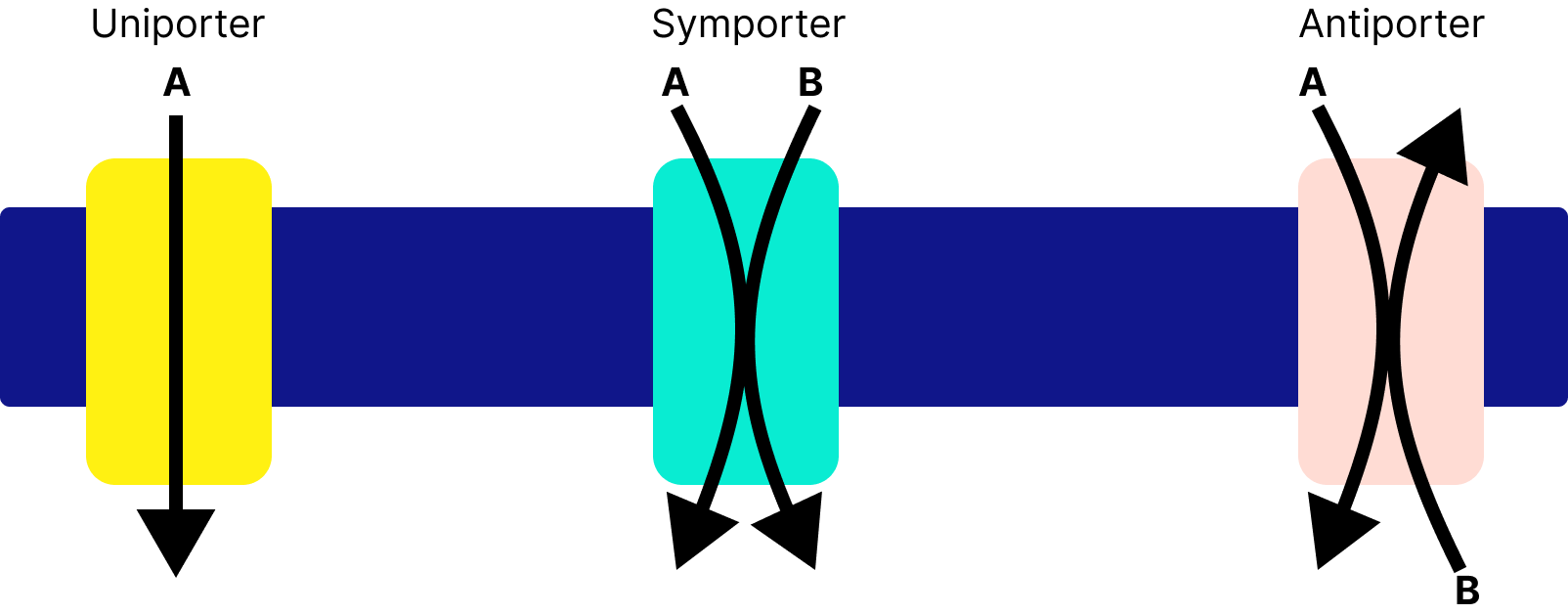
Types of Facilitated Diffusion
Active Transport:
Pumps molecules against a concentration gradient using energy. Membrane proteins are responsible for this.
Pumps are mobile carrier proteins that are used in active transport.
Pumps are capable of transporting substances from low to high concentrations. The carrier proteins carry only the specialised molecules across the membrane.
Differences Between Passive and Active Transport are Given Below:
Passive Transport | Active Transport |
It does not necessitate the use of cellular energy. | Cellular energy is required. |
It moves from a high concentration region to a low concentration region. (along the concentration gradient) | It moves from a low concentration region to a high concentration region. (against the concentration gradient) |
All soluble molecules, such as oxygen, water, lipids, carbon dioxide, sex hormones, and others, must be transported. | All molecules like proteins, ions, large cells, complex sugars, and so on must be transported. |
Passive Transport is a physical activity. | Active transportation is a fluid process. |
It is not entirely non-selective. | It is extremely selective. |
Passive transportation is a relatively slow process. | Active transportation is a quick process. |
Carrier proteins are not needed in passive transport. | Carrier proteins are needed for active transport. |
Plant-Water Interactions:
Terrestrial plants absorb a lot of water and emit the majority of it as water vapour through transpiration.
Water Potential:
Water Potential (or Ψw ) is a term that refers to the amount of water.
Solute potential or Ψs and pressure potential or Ψp determine water potential.
Kinetic energy exists in water molecules. The higher the water concentration in a system, the higher the kinetic energy or water potential. As a result, pure water has the highest water potential and is equal to zero.
The Greek symbol for water potential is Ψw, and it is measured in Pascals of pressure (Pa).
At standard temperature and pressure, pure water pressure is assumed to be zero. Because there is less water in a solution, it has a lower water potential than water i.e. below zero or negative.
Solute potential (or Ψs) is the magnitude of the decrease in water potential caused by the dissolution of a solute. The potential of a solute is always negative. The solute potential decreases as the number of solute molecules in the solution increases.
The water potential of pure water or a solution increases when it is subjected to a pressure greater than atmospheric pressure. The pressure potential is usually positive. (Ψp) stands for pressure potential.
Both solute and pressure potential affect a cell's water potential. The following is the relationship:
Ψw = Ψs + Ψp
Osmosis:
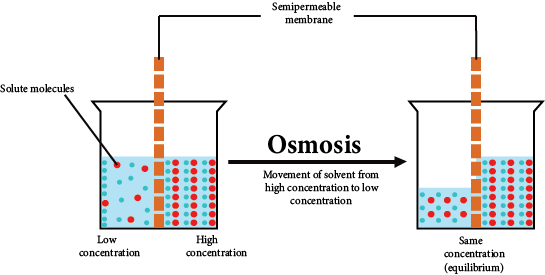
Process of Osmosis
Water diffusion through a semipermeable membrane is referred to as osmosis. The pressure gradient and the concentration gradient influence the net direction and rate of osmosis. Until equilibrium is attained, water will migrate from a higher concentration region to a lower concentration region.
The pressure needed to keep water from diffusing is known as osmotic potential. The higher the concentration of solute, the higher the pressure needed to prevent it from diffusing.
Osmotic pressure and osmotic potential are numerically equal, but the sign is reversed. The positive pressure of osmotic pressure is greater than the negative pressure of osmotic potential.
Osmotic pressure is the hydrostatic pressure that equalises and inhibits the osmotic influx of water into concentrated solution.
The osmotic potential of a solution is the ability of dissolved solutes to cause flow of water into it across a semipermeable membrane.
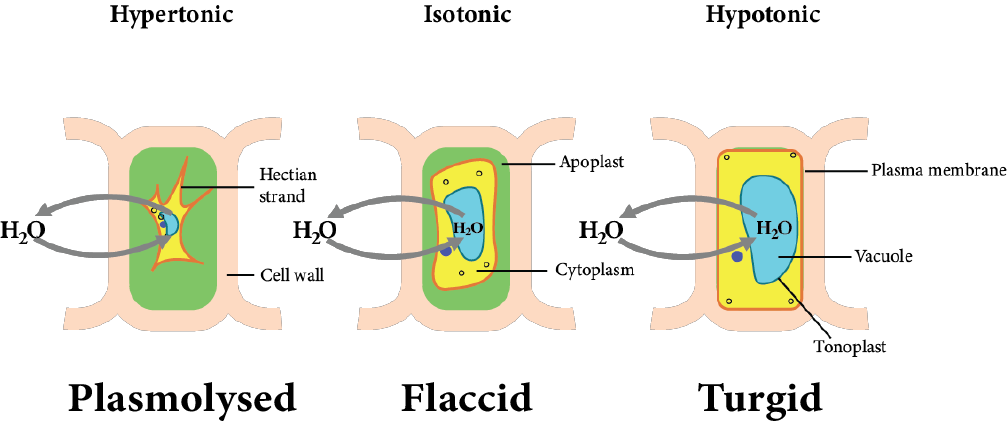
Plant Cells are Present in Hypertonic, Isotonic, and Hypotonic Solutions
Isotonic solutions have a surrounding solution that balances the cytoplasm's osmotic pressure.
The term hypotonic refers to a solution that is more dilute than the cytoplasm. Swelling occurs when cells are placed in a hypotonic solution.
The exterior solution is more concentrated than the cytoplasm, making it hypertonic. The cell shrinks in a hypertonic solution.
Difference Between Isotonic, Hypotonic and Hypertonic are as following:
Isotonic | Hypotonic | Hypertonic |
Isotonic solutions are solutions having equal osmotic pressures. | Hypotonic solutions are solutions having lower osmotic pressures. | Hypertonic solutions are solutions having comparatively higher osmotic pressures. |
Have equal solute concentrations. | Have a low concentration. | Have a high concentration. |
Isotonic environments show no effect on cells. | Hypotonic environments cause cells to swell. | Hypertonic environments cause cells to shrink. |
Isotonic solutions are not helpful in food preservation. | Hypotonic solutions are not helpful in food preservation. | Hypertonic solutions are helpful in food preservation |
Plasmolysis:
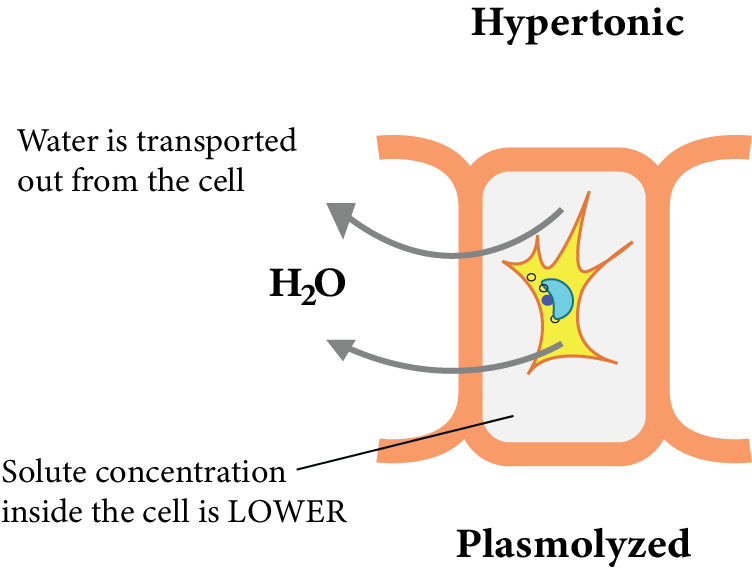
Plasmolysed Plant Cell
Plasmolysis occurs when a hypertonic solution separates a cell's cytoplasm from its cell wall.
Water potential of cytoplasm increases that results in shrinkage of the cells due to no turgor pressure.
Plasmolysis pressure is usually reversible when the cell is placed in a hypotonic solution.
The pressure that builds up on the wall as a result of the movement of water inside is known as turgor pressure. It is in charge of cell extension and expansion.
Imbibition:
Water is absorbed by solid colloids, causing them to expand in volume, which is referred to as imbibition. Seeds and dry woods, for example, can absorb water. Because water moves from a greater concentration to a lower concentration, imbibition is a type of diffusion.
Imbibition requires a water potential gradient between the absorbent and the liquid ingested.
Water is transported across long distances in plants using a mass or bulk flow system. It is the bulk movement of a substance from one spot to another caused by a pressure differential between two points.
Translocation is the mass transport of chemicals via the conducting or vascular tissue of plants.
Water and mineral salts are transported through the xylem, and some minerals are transported through the xylem.
Water and mineral salts, as well as some organic nitrogen and hormones, are transported from the roots to the aerial regions of plants via xylem.
Organic and inorganic solutes are transported from leaves to various parts of the plant by phloem.
Water Absorption by Plants:
Diffusion allows water and mineral solutes to be absorbed by root hairs. Two channels carry the absorbed water to the deeper layer.
The pathways of apoplast and symplast.
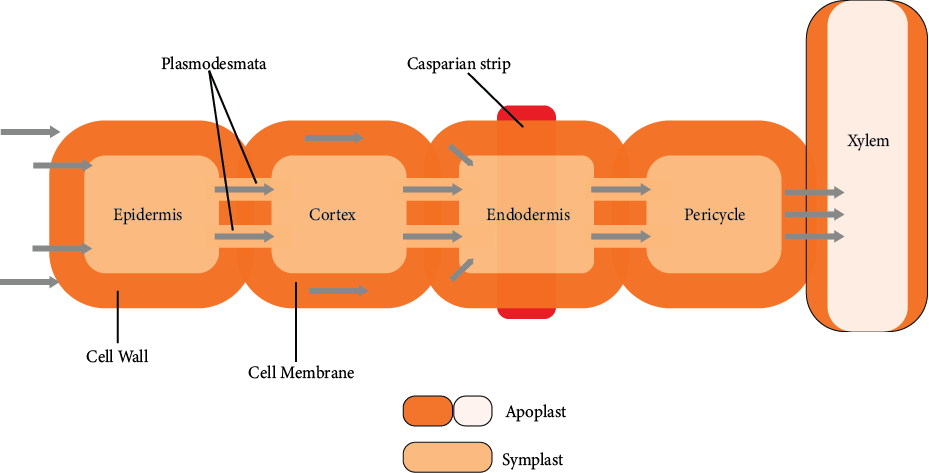
Symplast and Apoplast Pathways
The nonliving components of the plant body, such as cell walls and intercellular spaces, make up the Apoplast pathway, whereas the living parts of the plant body, such as protoplast coupled to plasmodesmata, make up the Symplast pathway.
Because cortical cells are loosely packed and pose no resistance to water movement, the majority of water in roots flows down the apoplast channel.
The endodermis, the innermost layer of the cortex, is resistant to water due to a suberized matrix known as the Casperian strip.
Water molecules are routed through non-suberized wall areas.
Mycorrhiza:
The symbiotic relationship between a fungus and angiospermic roots is known as mycorrhiza. The fungal filaments establish a network around the young root, allowing it to have a broad surface area where mineral ions and water from the soil can pass through. Minerals and water are provided by the fungus, and organic and nitrogen-containing chemicals are provided by the roots.
Translocation of Water:
Ascent of sap is the upward transfer of water from the roots to the tips of stem branches and their leaves.
Ascent of Sap Theory:
J.C.Bose proposed the vital force theory in 1923. According to this, the root's innermost cortical cells collect water from the outside and pump it into xylem channels.
Priestley proposed the root pressure theory in 1916. Root pressure is the positive pressure that builds up in the xylem sap of plants' roots. It's possible that it's responsible for forcing water up to modest heights in plants.
Guttation is the loss of water in the liquid phase by herbaceous plants from the tips of leaf blades.
Due to the effect of surface tension, the water rises in small diameter tubes retained in water-filled vessels. Similarly, adhesion and cohesion cause water to ascend in the walls of xylem channels. The Hypothesis of Capillarity is the name of this theory.
Dixon and Joly proposed the Cohesion Tension theory in 1894. According to this view, water is primarily drawn from the leaves due to the driving force of transpiration. The cohesive force keeps the water molecules linked to one another. Due to the adhesive force between the walls of xylem vessels and the water molecules, water molecules remain stuck to the xylem walls. The water column of the plant is passively drawn up from the roots to enormous heights due to the tension created by transpiration.
Transpiration:
Transpiration is the loss of water from plants' aerial portions in the form of water vapour.
Transpiration occurs more rapidly during high temperature and when the moisture less wind blows in the plant’s surroundings.
A transpiration pull can be simply described as a biological process that generates pulling force within the xylem tissue. This force aids in the movement of water upward into the xylem vessels. Water loss in the mode of vapours is observed during this process.
Phloem Solute Transport:
The flow of phloem from the source to the sink is known as phloem transport.
Food (sucrose) is transported from the source to the sink by phloem. The part of the plant that synthesises food is known as the source, while the section where food is utilised or stored is known as the sink.
Depending on the season or the needs of the plants, the source and sink can be reversed. As a result, movement in the phloem is bi-directional. Phloem sap is mostly made up of water and sucrose, but it also transports other sugars, hormones, and amino acids.
Pressure Flow Hypothesis:
It is the most widely recognized theory for sugar transport from source to sink. Photosynthesis produces glucose, which is then transformed into disaccharides (sucrose). Sucrose is actively transported into companion cells and ultimately into sieve tube cells.
When phloem is loaded at the source, a water potential gradient is created, which aids mass transport in the phloem.
Phloem sieve tube cells create a long column with pores in their walls, known as sieve plates. Cytoplasmic strands form a continuous filament as they pass past the sieve plates. The sap in the phloem is moved by hydrostatic pressure created in sieve tube cells.
Sugar is actively transported out of the phloem as complex carbs at the sink. The loss of solute causes a high water potential in the phloem, which causes water to flow out and back into the xylem.
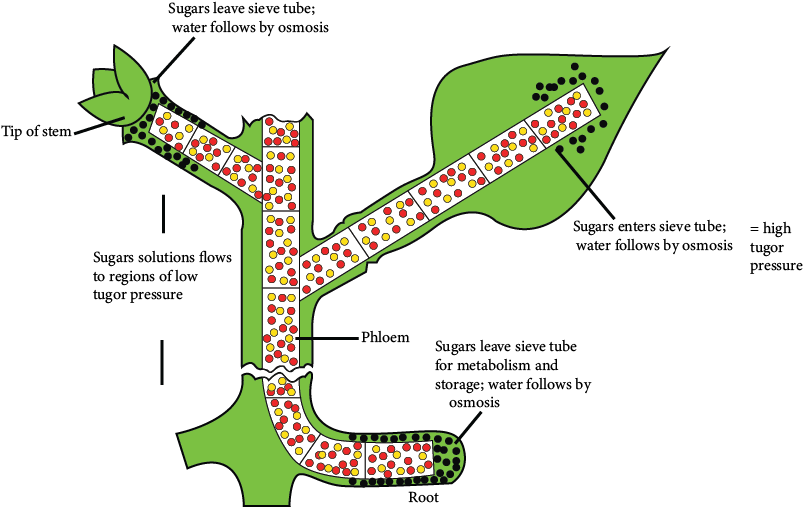
Sugar Transport from Source to Sink
Key Points to Remember:
Plants absorb a wide range of inorganic elements like ions and salts from their exterior environment, particularly water and soil.
The flow of these nutrients from the surroundings into the plant, and from one plant cell to another, entails crossing a cell membrane.
Diffusion, facilitated transport, and active transport are all methods of transport across the cell membrane.
Water and minerals soaked up by roots are transported by xylem, while organic material produced in leaves is transferred to other parts of the plant by phloem.
In living organisms, the two methods of nutrient transport across cell membranes are passive transport like diffusion and osmosis and active transport.
Passive transport involves the movement of nutrients across a membrane via diffusion, which is always energy-free because it occurs along the concentration gradient.
Substances' diffusion is determined by their size and solubility in water or organic solvents.
Osmosis is a type of water diffusion that is affected by pressure and concentration gradients across a selectively permeable membrane.
Energy in the form of ATP is used to pump molecules across membranes against a concentration gradient.
Water potential is the energy stored in water molecules that aids in water movement. Solute potential and pressure potential are the determinants of water potential.
Cell osmotic behaviour is affected by the surrounding solution. If the cell's surrounding solution is hypertonic, it is plasmolyzed.
Water is absorbed by seeds and drywood through a type of diffusion known as imbibition.
Higher plants have a vascular system that consists of xylem and phloem and is responsible for translocation.
Water, minerals, and food cannot be migrated within a plant's body solely through diffusion. As a result, they are transported by a mass flow system, which is the movement of a bulk substance from one zone to another as an outcome of pressure differences between the two zones.
Water absorbed by root hairs enters root tissue through two distinct pathways, apoplast and symplast.
Root pressure can travel various ions and water from the soil up to a small height in stems.
The most acceptable model for explaining water transport is the transpiration pull model. The water loss through stomata in the form of vapours from plant parts is referred to as transpiration.
The transpiratioraten is affected by temperature, light, wind speed, wind speed, and the number of stomata.
Extra water is also removed from plants via the tips of their leaves via guttation.
Phloem is in charge of transporting food (mostly sucrose) from the source to the sink.
The translocation process that occurs in phloem is bidirectional, with a variable source-sink relationship. The pressure-flow hypothesis explains phloem translocation.
Importance of Transport in Plants NEET Notes for Class 11 Chapter 11
This chapter majorly focuses on plant transportation and other similar aspects. In the plant water relationship, it presents how water is essential for all kinds of activities. Terrestrial plants absorb a lot of water and emit the majority of it as water vapour through transpiration. In both agricultural and natural ecosystems, water is the limiting factor for plant growth and output. Kinetic energy exists in water molecules. Higher the water concentration in a system, higher the kinetic energy. As a result, pure water has the most water potential.
The chapter further talks about osmosis, which is diffusion of water throughout the semi-permeable membrane. Until equilibrium is attained, water will migrate from a zone of higher concentration to a region of lower concentration. In these revision notes, students get to learn how plants absorb water. Diffusion allows water and mineral solutes to be absorbed by root hairs. Two channels carry the absorbed water to the deeper layer. The two pathways are- Apoplast Pathway and Symplast Pathway.
Benefits of Using Vedantu’s Transport in Plants Class 11 Notes
One of the major benefits of using these Transport in Plants Class 11 notes is the easy language of the notes which students can follow while learning about the chapter. Since the chapter carries many scientific terms, students may find it challenging to understand. Vedantu's subject matter experts have used simple and straightforward language that will aid in students’ easy comprehension. Some other benefits are-
The amount of time it takes to study this chapter will be significantly reduced. It will assist you in comprehending and relating the method described in this chapter to the questions posed. As a result, you will be able to accurately answer questions and achieve higher exam scores.
The Transport in Plants notes PDF will help you with the last-minute learning. It will help you save a lot of time when it comes to revision before NEET.
You can also observe how the experts have explained the answers to the questions. Learn from the answering approaches and improve your ability to frame accurate answers in order to get a higher score in the competitive exam.
Download Transport in Plants Notes PDF
Complete your study material for this chapter by downloading the free version of Transport in Plants Notes PDF. Seek direction from the simple explanations provided in these notes for all of the concepts. You can use the PDF for last minute revision.
NEET Biology Revision Notes -Chapter Pages
NEET Biology Chapter-wise Revision Notes | |
Transport in Plants Notes | |
Other Important Links
Other Important Links for NEET Transport in Plants Notes |
FAQs on Revision Notes on Transport in Plants for NEET 2026
1. What is water potential?
Water potential is a concept that is essential to grasping the concept of water movement. Solute potential and pressure potential determine water potential. The Greek symbol for water potential is Psi, and it is measured in the pressure unit Pascal (Pa).
At standard temperature and pressure, pure water pressure is assumed to be zero. Because there is less water in a solution, it has a lower water potential.
2. What is the Apoplast Pathway?
Apoplast Pathway is made up of non-living plant elements like cell walls and intercellular gaps. The movement of water is somewhat unrestricted. It is more efficient. The Apoplast Pathway is unaffected by the root's metabolic status.
3. What is Mass Flow Hypothesis?
Mass Flow Hypothesis is the most widely recognised theory for sugar transport from source to sink. Photosynthesis produces glucose, which is then transformed into disaccharides (sucrose). Sucrose is actively transported into companion cells and ultimately into sieve tube cells. When phloem is loaded at the source, a water potential gradient is created, which aids mass transport in the phloem.
4. What do you understand by transportation in plants?
Transportation is the natural process of moving water and essential nutrients to all sections of the plant in order for it to survive.

























